Discovering the Diverse Uses of Clay Beads in Jewelry
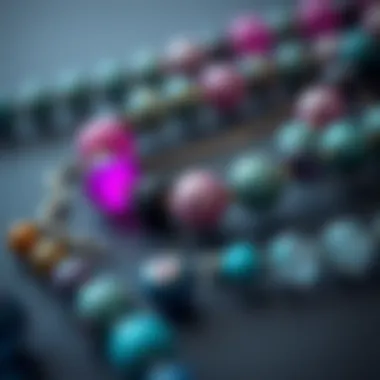
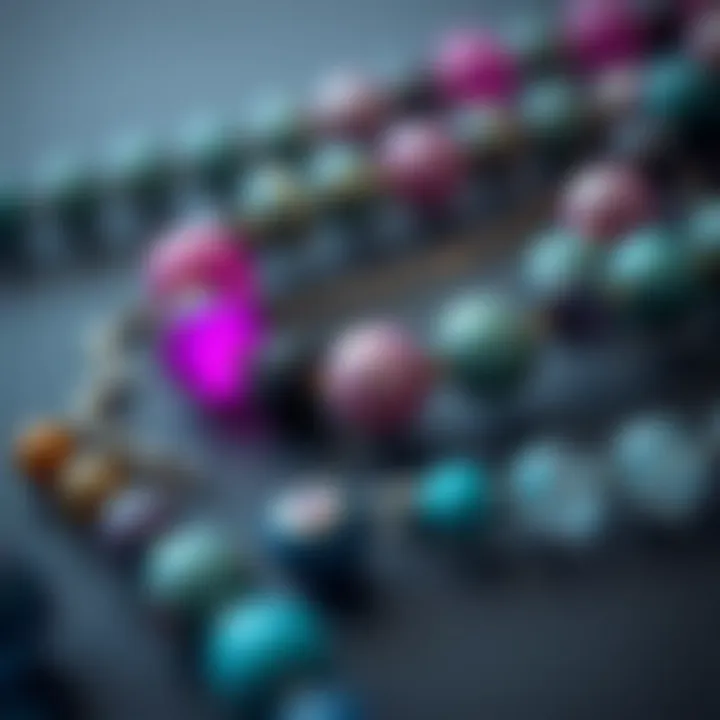
Intro
Clay beads have carved a niche for themselves in the realm of jewelry-making, allowing artisans a unique medium that combines creativity and craftsmanship. From ancient civilizations to modern ateliers, the evolution and versatility of clay beads play a fascinating role in the development of wearable art. This journey into the multifaceted world of clay highlights not just their aesthetic appeal but also their historical significance and practical applications in contemporary design.
When we think about jewelry, one often conjures images of glittering gemstones or shining metals. Yet, clay beads stand out for their diverse textures, colors, and forms. These handmade pieces can range from smooth and polished to rugged and textured, making them perfect for every style and occasion.
This article sheds light on various aspects of clay beads, focusing on their historical context, types of clay, molding techniques, and finishing touches that can elevate a simple bead into a centerpiece of an elaborate jewelry design. Whether you're a hobbyist just dipping your toes into jewelry making or a seasoned artisan looking to refine your skills, this guide aims to enrich your understanding and appreciation of this unique medium.
Prelims to Clay Beads
The realm of clay beads in jewelry making holds a fascinating blend of artistry and craftsmanship. They are not merely materials but avenues for creativity and expression. When one delves into the nuances of clay beads, one uncovers not just their aesthetic appeal but also their versatility in design, accessibility for creators of varying skill levels, and cultural significance over centuries. Understanding clay beads serves as a foundational stepping stone for anyone looking to explore the intricate world of jewelry creation.
Defining Clay Beads
Clay beads are small decorative elements fashioned primarily from different types of clay. They come in a plethora of shapes, sizes, and colors, catering to diverse aesthetic preferences and design styles. These beads can be molded by hand or crafted using specialized tools, allowing for personal expression in every piece. They can be adorned with intricate patterns, textures, and finishes, setting the stage for unique jewelry creations.
Among the different types of clay, we find polymer clay, air-dry clay, and ceramic clay, each bringing its own characteristics into play. Polymer clay, for example, is a man-made material that becomes pliable when warmed and hardens upon baking. In contrast, air-dry clay remains soft until it naturally dries without the need for heat. These materials provide a vast landscape for crafting, ensuring that what you create is truly one-of-a-kind.
In the hands of skilled artisans and novice hobbyists alike, clay beads offer an inspiring medium for enhancing jewelry aesthetics. The defining feature of clay beads is their adaptability, making them suitable for a variety of styles—from bohemian to contemporary chic.
Historical Context of Clay Beads
Historically, clay beads have stood the test of time, serving as ornamental pieces across cultures. From ancient civilizations that adorned themselves with tribal beads for spiritual purposes to modern artists who employ them for purely aesthetic reasons, clay beads carry a rich narrative. In various cultures, beads have symbolized status, protection, or connectivity among communities.
The inception of clay beads can be traced back thousands of years, with archeological findings revealing their use in ancient Egypt, Mesopotamia, and beyond. Communities would mold and shape local clays, creating rudimentary but significant pieces that held cultural meaning. As trade routes expanded, so too did the variety and sophistication of clay bead designs, influenced by cross-cultural exchanges. This historical significance adds depth to contemporary bead crafting—understanding that each bead molds a story rooted in tradition.
Types of Clay Used in Bead Making
Understanding the types of clay used in bead making is crucial for anyone diving into this artistic craft. Each clay variety presents unique properties and benefits, making certain types more suitable for particular designs or techniques. Knowing the nuances among these materials helps artisans make informed decisions and create eye-catching pieces.
Polymer Clay
Properties
Polymer clay is popular among jewelry makers for its versatility and ease of use. It comes in a wide array of colors, and being a synthetic material, it has excellent moldability. One standout property is its non-toxic formula, making it safe for both adults and children to work with. The fact that polymer clay can be baked in a home oven to harden it gives it a distinct advantage; once cured, it has durability that is often desirable in jewelry making. However, it can be sensitive to excessive heat during baking, which can lead to discoloration or other unwanted changes.
Popular Brands
Several brands dominate the polymer clay market, each offering unique features that cater to different needs. For instance, Sculpey is known for its flexibility and smooth finishes, making it a favorite among both beginners and established artists. Fimo, on the other hand, is recognized for its rich pigments and excellent blendability, which is a big plus when creating custom shades. The choice of a particular brand often hinges on the specific projects an artisan has in mind, as each brand may have varying softness, texture, and baking requirements, which can influence the final outcome.
Applications
Polymer clay is inherently versatile, making it suitable for a wide range of applications in jewelry making. It can be shaped into intricate beads, charms, and even pendants with relative ease. As it can mimic other materials like wood, stone, or glass, many creators use it to achieve specific looks without the weight or cost of the materials it imitates. However, while polymer clay offers endless possibilities, one disadvantage is its vulnerability to scratching or chipping if not treated with protective coatings post-baking.
Air-Dry Clay
Characteristics
Air-dry clay sets itself apart by not requiring any heat for curing. This property makes it appealing for informal projects and crafts involving children, as it eliminates the need for an oven. It's lightweight and easily sculptable, allowing for finer details and intricate designs. However, it's worth noting that while it can be quite resilient once dried, it's generally less durable than its polymer or ceramic counterparts. Additionally, its drying times can vary significantly depending on thickness and environmental factors, which is a detail to consider when planning a project.
Color Variations
One of the attractive features of air-dry clay is its broad range in color variations. Available in several hues, it can be easily painted or altered with water and pigments to achieve bespoke shades. This enables artisans to personalize their crafts without needing additional layers of paint post-drying. However, the colors in air-dry clay can sometimes be more subdued compared to those in other mediums, so opting for vibrant final appearances often requires careful planning during the initial stages.
Usage Tips
To make the most of air-dry clay, here are some handy tips:
- Knead thoroughly before use to ensure uniform consistency.
- Work quickly, as it can dry out if left exposed to air too long.
- Seal with varnish once dry to prolong the piece's life; this also helps enhance colors and provides a protective layer against moisture.
Ceramic Clay
Firing Processes
Ceramic clay requires a firing process that makes it quite different from the other types. This involves baking the shaped clay in a kiln at high temperatures, transforming it into a sturdy medium. The firing process allows for greater durability and versatility, making it perfect for intricate designs and textures. However, the need for specialized equipment can be a barrier for those embarking on jewelry making as a hobby.
Durability
When compared to polymer and air-dry clays, ceramic clay offers remarkable durability. Once fired, pieces can withstand high temperatures and are generally quite resilient to wear and tear. This makes ceramic clay particularly appealing for items that will see frequent use. However, its fragility pre-firing remains a concern; delicate shapes can easily break before they reach the kiln.
Finishing Options
Ceramic clay lends itself well to various finishing options, perhaps best illustrated through glazing. Glazing adds not only a protective coat but also a splash of color or sheen that is almost impossible to replicate with raw clay. Finishing can be complicated by the need to consider how colors will react during the firing process, which is pivotal for achieving desired results. The potential for different glazes means artisans can experiment and achieve truly unique effects, but it also demands a bit of practice to avoid mishaps during the firing stage.
Using the right type of clay is fundamental for creating beautiful and lasting jewelry pieces. Each clay material brings its own set of characteristics to the table, providing different benefits and considerations that artisans need to factor into their designs.


Molding and Shaping Techniques
Molding and shaping techniques are the backbone of clay bead creation, defining not just the form but also the character of the end jewelry piece. Successful techniques can elevate a simple bead into a statement of art. Understanding these methods involves grasping their significance within this craft, as they influence everything from the aesthetic appeal to the functional durability of jewelry. The right technique can ensure consistency, while unique approaches can foster creativity and originality in design.
Hand Molding Methods
Hand molding methods offer artists the freedom to express their individual creativity. Not only are these methods accessible, but they allow for unique designs that can’t be replicated easily, adding a personal touch to each piece. Artists can simply start with a lump of clay, knead it until pliable, and form shapes manually. This process does require practice, but it can also be incredibly rewarding.
Using hand molding, one can create beads of varying sizes—perfect for custom designs. Additionally, hand techniques can also enhance tactile qualities, making each bead distinct to the touch. Knowing how to manipulate clay by hand not only contributes to originality but also fuels a deeper connection with the art itself.
Using Molds for Consistency
Types of Molds
Using molds is a popular technique among jewelry makers looking to achieve consistency. Types of molds can include silicone, metal, or even homemade versions crafted from materials like plaster. Silicone molds, for example, are favored for their flexibility and reusability. A key characteristic of these molds is their ability to produce identical shapes repeatedly, which is a huge benfit for those looking to create larger runs of similar designs.
Another appealing factor is the precise detail that molds can capture, ensuring that the beads echo the designer’s vision each time. While molds can streamline the crafting process, they might limit a designer’s creative range compared to free-hand methods. This balance is essential when deciding on the best approach for a specific project.
Creating Original Designs
Creating original designs with molds can be an exciting challenge for bead makers. With a little ingenuity, customizing a mold or modifying existing ones can lead to unexpected and captivating results. The key characteristic here is adaptability; seeing potential in every mold as a canvas for innovation is crucial for success.
For instance, adding embellishments or altering the shape slightly can yield unique pieces while still benefiting from the mold's consistency. The trade-off here is a potential lack of spontaneous forms often seen in hand-molded beads. However, original designs that emerge from clever mold manipulation can often make up for that. The strength of this technique lies not just in replication, but in the potential for tailored artistry.
Texturing Techniques
Tools for Texturing
Texture adds a visual and tactile dimension to clay beads. Using the right tools for texturing, like stamps, rollers, or custom tools, can significantly enhance a design's depth. What's crucial is the choice of tools; different textures can evoke different feelings or complement specific materials. For example, textured backgrounds can make a shiny glaze pop, drawing attention to details.
Tools for texturing often allow for a high degree of personalization, giving each bead a unique flair while also being relatively easy to use. While it requires some technique to achieve desired effects, the end result can drastically alter the overall appearance of jewelry. Therefore, investing time into mastering texturing tools can pay significant dividends in craftsmanship.
Incorporating Patterns
Incorporating patterns into bead designs is a fantastic way to elevate the sophistication of the jewelry. Patterns can stem from nature, cultural designs, or simply creative ideas. This process invites a diverse range of styles and choices, implying that one’s artistry has bounds that are defined only by individual imagination.
The key here is balance—tying patterns into your work ought to feel harmonious. A distinct advantage of this technique is its ability to tell a story; each pattern can serve as a narrative thread that attracts attention and invites inquiry from the observer. However, on the flip side, overly complex patterns might risk overshadowing the overall design, requiring discretion and insight to master.
Through mastering molding and shaping techniques, anyone can engage more effectively with the craft of jewelry making, encouraging both technical skill and personal expression. Such skills enable artisans to achieve a harmony of aesthetic and functionality, leading to truly remarkable pieces of art.
"The beauty of clay beads lies in their versatility, becoming a true expression of the artisan's vision, in every mold and twist of the hand."
Molding and shaping may seem like mere foundational techniques, but they serve as milestones on the journey to becoming an accomplished jewelry maker.
Finishes and Surface Treatments
Finishes and surface treatments are critical components in the craft of jewelry making—especially when using clay beads. They not only enhance the visual appeal but also offer protection and durability to the finished pieces. Without a proper finish, even the most beautifully crafted clay beads can lose their charm over time due to wear and tear. Therefore, understanding various finishing techniques can elevate a simple piece of jewelry into a wearable art that stands the test of time.
Painting and Sealing
Paint Types
When it comes to painting clay beads, one must carefully choose the paint type. Acrylic paints are the go-to option for many artisans. They adhere well to the clay's surface and retain their vibrancy over time. Moreover, acrylics are easily mixed and come in a myriad of colors, allowing for extraordinary customization. However, it's worth noting that certain brands can require a longer drying time, which can be a drawback when time is of the essence in projects.
- Key Characteristic: Fast-drying and versatile
- Unique Feature: Wide range of colors and finishes available, such as matte and glossy.
- Advantages: Easy to apply and cleanup; no toxic fumes.
- Disadvantages: Some may chip more easily than others, requiring additional sealing for longevity.
Protective Coatings
Applying a protective coating can significantly extend the life of clay bead jewelry. Common options include varnishes and sealers specifically designed for craft projects. These coatings create a barrier against moisture and dirt, safeguarding the bead's painted or unpainted surface.
- Key Characteristic: Durable and moisture-resistant
- Unique Feature: Many coatings provide a glossy finish that enhances the colors of the beads.
- Advantages: Shields against scratches and enhances longevity.
- Disadvantages: Some coatings can alter the hue of the paint, requiring careful testing before application.
Glazing Techniques
Glazing offers a distinctive finish for ceramic and some types of polymer clay beads. This technique involves applying a glass-like layer that not only adds gloss but also impacts color depth. Glazed beads often appear more polished and professional. The process typically requires a kiln, as high temperatures are needed to set the glaze correctly.
- Glaze comes in a variety of formulations, each providing different textures and finishes, such as matte, glossy, or satin.
- Glazing can also introduce intricate designs that can’t be replicated through painting alone.
Special Effects
Using Metallics
Metallic finishes have gained traction among jewelry makers, providing an eye-catching appeal. Products such as metallic paint or powders can be applied to create shimmering effects, giving beads a unique look that resembles precious metals. This can elevate the aesthetic of a piece, making it stand out in a sea of handcrafted jewelry.
- Key Characteristic: Provides a reflective quality that catches light.
- Unique Feature: Can mimic the look of actual metals without the accompanying cost.
- Advantages: Adds a luxurious feel and can enhance simpler designs.
- Disadvantages: Can be tricky to apply evenly and may require multiple coats to achieve the desired effect.
Creating Faux Finishes
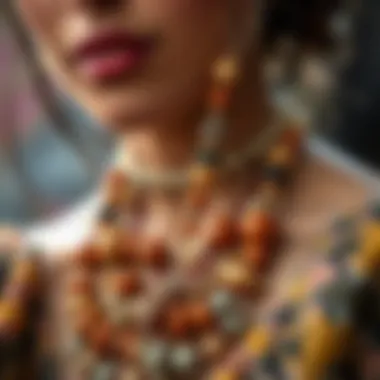
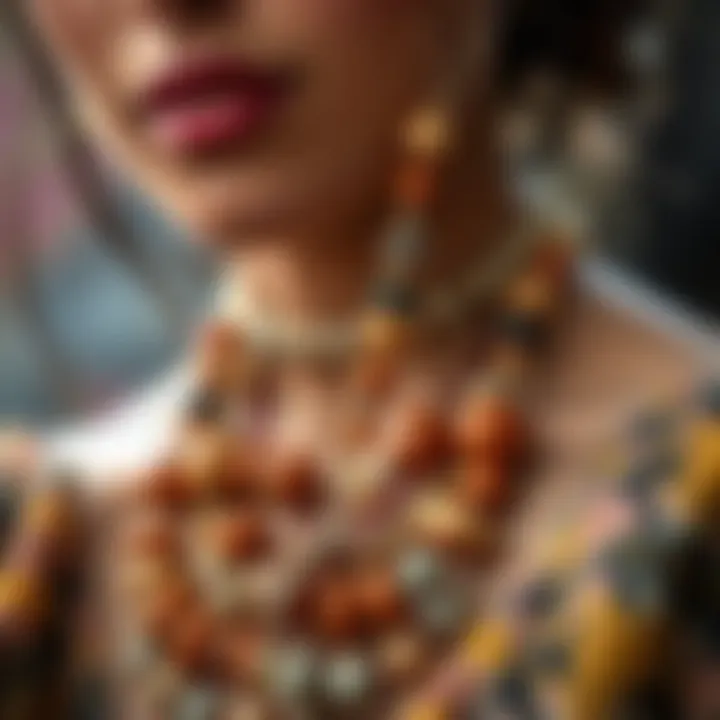
Faux finishes can be a creative way to imitate natural materials like wood, stone, or even leather on clay beads. Techniques can range from using paint to applying textured layers or powders. These methods allow artisans to achieve a high-end look without breaking the bank.
- Key Characteristic: Versatile and imaginative approach to bead design.
- Unique Feature: Allows for personal expression without the constraints of traditional materials.
- Advantages: Expands possible design options significantly.
- Disadvantages: Some faux finishes can require patience and skill to master.
In summary, the right combination of finishes and surface treatments not only enhances the beauty of clay bead jewelry but also plays a substantial role in the longevity and durability of each piece. Through mastering different painting, sealing, glazing, and texturing techniques, jewelry makers can truly make their creations shine.
Design Considerations in Jewelry Making
When it comes to crafting jewelry, especially with clay beads, navigating the interplay between design and function is crucial. Crafting isn’t just about throwing materials together; it’s an art form requiring a fine balance between aesthetics and practicality. Ultimately, this balance elevates the finished piece while ensuring it meets the wearer's needs.
Balancing Aesthetics and Functionality
In jewelry design, aesthetics refers to how visually appealing a piece is, while functionality focuses on how well the piece serves its intended purpose. For instance, a necklace that’s stunning but too heavy or uncomfortable to wear may gather dust in a box instead of being adorned.
A well-designed piece considers both these aspects simultaneously. Using lightweight clay beads can preserve comfort without sacrificing style. Incorporating vibrant colors or intricate patterns can attract admirers, but it's imperative to ensure the design is also practical. A beginner may find starting with simple designs is the way to go, gradually experimenting with more complex aesthetics as confidence grows.
A great design does more than look good; it feels good and works well.
Incorporating Other Materials
Jewelry design is no longer limited to just clay beads. Combining different materials can create a piece of art that stands out. Below, we'll look into two popular options: metal and natural stones.
Combining with Metal
Combining clay beads with metal can dramatically enhance the visual appeal of jewelry. This combination brings a unique flair, as metal provides a sleek contrast to the often organic feel of clay. For example, using brass or copper findings strategically can align well with the colors of polymer clay, adding a sophisticated touch. Another advantage of metal is durability; where clay beads may chip or crack, metal components hold up quite well over time.
However, a disadvantage is that working with metal often requires specialized tools or experience, which can be a barrier for some artisans. Despite this, the benefits—like the ability to add weight and solidity to an otherwise lightweight piece—often make the effort worthwhile.
Natural Stones
Natural stones present another captivating avenue for jewelry design. Each stone carries its own artistic narrative, offering unique textures and colors not often found in synthetic materials. The organic patterns within a piece of jade or the vibrant hues of turquoise can complement clay beads beautifully. Crafting a bracelet or necklace with both materials invites a diverse range of styling opportunities.
Moreover, natural stones often appeal to customers who value authenticity and nature, making them a popular choice in the marketplace. However, they do come with certain cons. Stones can be heavier than clay beads, making them less suitable for larger designs. Overall, combining natural stones with clay offers both depth and character to jewelry pieces, enriching the collector's experience.
By carefully considering the combination of clay beads with other materials, makers not only cater to their artistic vision but also ensure the jewelry is meaningful and wearable.
Creating Unique Pieces
In the realm of jewelry making, the pursuit of originality and personal expression is paramount. Creating unique pieces allows artisans to stand out in a crowded market and makes each item resonate with a story or feeling that is distinctly their own. This process not only brings satisfaction to the creator but can also forge a connection with the wearer. When design becomes a reflection of individual creativity, it transcends mere decoration and becomes wearable art.
Inspiration Sources
Nature
The natural world can be a wellspring of inspiration. With its vast array of colors, shapes, and textures, nature offers endless possibilities for design. For instance, the patterns seen in leaves, flowers, and even animal fur can inspire the design and formation of clay beads. The use of natural colors — earthy browns, vibrant greens, or soft pastels can evoke a sense of tranquility and harmony in a piece of jewelry.
A key characteristic of nature is its organic forms, which can easily translate into the soft curves or rough edges of handcrafted clay beads. A consideration here is to ensure the interpretation respects the essence of the natural object; over-exaggeration can lead to a disconnect between inspiration and execution. Ultimately, nature provides a rich tapestry of design elements that can yield very personal, yet universally appreciated, jewelry pieces.
Art
Art plays a crucial role in influencing the aesthetics of clay bead jewelry. From ancient civilizations to modern movements, artists have explored the intersection of form, color, and texture — all of which are incredibly relevant to clay bead design. Whether drawing inspiration from the bold strokes of Van Gogh or the minimalism of contemporary artists, each style offers its own take on visual storytelling.
A major advantage of using art as a source of inspiration is the potential for vibrant color palettes and imaginative themes. The unique feature of this approach lies in its flexibility — a single piece can mix different artistic influences, creating a collage of styles. However, one must be cautious that interpretations do not stray too far into imitation, risking the originality of the work.
Cultural Influences
Cultural influences offer another layer to the depth of unique clay bead designs. Each culture has its artistry, traditions, and symbolism, which can be infused into jewelry pieces. For example, Native American beadwork often utilizes intricate patterns representing nature and spirituality, providing a historical and cultural narrative that enriches the jewelry's story.
The beauty of drawing from cultural influences is seeing the diversity in design; what one culture sees as auspicious or beautiful, another might interpret differently. The challenge, however, lies in approaching these influences with respect and understanding, ensuring that designs honor their origins without appropriating them. Thus, cultural inspirations can inspire authentic, meaningful designs that resonate deeply with both creators and wearers.
Trends in Clay Bead Jewelry
Current Market Trends
Staying abreast of current market trends is vital for any jewelry maker looking to create unique pieces. The clay bead market is witnessing a shift toward sustainability, with an increasing number of artisans using eco-friendly materials and practices. This trend reflects a growing consumer demand for ethical products, allowing artisans to align their creations with values that resonate with the modern buyer.
Another noticeable trend is the embrace of customizability. Many consumers seek personalized jewelry, and clay beads lend themselves well to this concept. Artisans can create bespoke pieces tailored to individual tastes or significant life events, making the products not just accessories but cherished mementos. The unique feature of this trend is an ever-expanding marketplace where each piece tells a personal story.
Forecasting Future Styles
Looking ahead, the forecasting of future styles in clay bead jewelry points toward a fusion of traditional craftsmanship and innovative technologies. As 3D printing technology becomes more accessible, it’s likely that artisans will leverage these advancements to experiment with forms and designs that were previously difficult or impossible to achieve.
Furthermore, there is a growing interest in the infusion of technology in the design process — think interactive or smart jewelry. Such developments may pave the way for clay bead pieces that not only feature aesthetic value but also functional capabilities. In the end, the evolution of styles will continue to reflect the shifting tides of consumer preferences, technological advancements, and global cultural exchanges.
Embracing uniqueness in jewelry creation is not just about standing out but connecting to deeper narratives and celebrating craftsmanship.
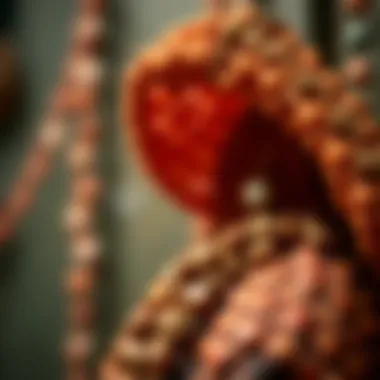

Practical Tips for Jewelry Makers
Creating exceptional jewelry pieces with clay beads requires not just creativity but also practical know-how that steers artisans toward successful outcomes. This section is pivotal as it encapsulates fundamental tips practitioners can employ to elevate their craft, ensuring quality, durability, and visual appeal of their creations.
Selecting Quality Materials
Choosing the right materials can make or break a piece of jewelry. The quality of clay beads significantly affects not just the aesthetic but also the longevity of the jewelry. To pick the best materials, it’s crucial to look for brands that have established reputations in the market. Various types of clay come with different properties and benefits, creating an array of choices for artisans. Here’s what to consider:
- Material Type: Always be clear on the type of clay being used. Not all clays are fashioned the same—certain types, such as high-quality polymer clay, are not only more durable but also offer vibrant colors compared to air-dry varieties.
- Supplier Reliability: It’s wise to source from reputable suppliers who offer comprehensive information about their products. Look for reviews or testimonials if possible.
- Cost vs. Quality: While it's tempting to go for cheaper options, often, they won't give the desired results. Investing in higher quality materials could save you from disasters that arise from inferior products.
Tools Essential for Crafting
Having the right tools for clay bead jewelry making can drastically improve your efficiency and the quality of your work. Tools not only help in shaping and molding but they also play a role in enhancing the finish. Here are two categories of tools worth falling in love with:
Basic Tools
Basic tools include the essentials that any novice or seasoned jewelry maker should have at hand. These often include:
- Cutting Tools: Basic blades or knives to sculpt and refine shapes.
- Rolling Pins: Useful for flattening clay into even sheets.
- Needle Tools: A must for adding details and textures.
The beauty of these basic tools lies in their simplicity and versatility. For instance, a good rolling pin allows for even thickness, which is vital for uniformity in bead shapes. They are affordable, yet they lay the foundation for creating stunning pieces.
Advanced Tools
Once you’re familiar with the basics, you might feel the need to elevate your crafting game, and that’s where advanced tools come into play. These often cater to intricate designs and finer details:
- Power Drills: For creating precise holes in beads that save a lot of time.
- Sculpey Tools: Specialized items designed for polymer clay, allowing for intricate designs and professional looks.
- Molding Machines: These help produce consistent shapes and patterns, a great time-saver.
Advanced tools might come with a higher price tag but often yield professional-grade results. They enhance workflow and elevate the precision of your work. Investing in these tools pays off in the long run, especially for those aiming to sell their crafts.
"Quality over quantity. Invest in tools and materials that set you apart!"
When arming oneself with these practical tips—from selecting high-quality materials to utilizing both basic and advanced tools—jewel makers can craft beautiful clay bead creations. Each element plays a role in achieving a perfect balance between art and functional design, ensuring your pieces are not just visually captivating but also built to last.
Care and Maintenance of Clay Jewelry
Taking care of clay jewelry is essential not only to sustain its beauty but also to prolong its life. Just like a good pair of shoes or a favorite dress, the way you treat and maintain your jewelry can make all the difference. Clay beads, despite their charm and creativity, require some tender loving care to maintain their allure and integrity. Proper cleaning and storage techniques can lead to years of enjoyment and admiration for your handcrafted pieces.
Cleaning Techniques
Cleaning clay jewelry should be approached with care. Unlike metal or stone jewelry, clay can be more sensitive to harsh chemicals. A gentle touch and the right method are key. Here are some techniques that can be beneficial:
- Use a Soft Cloth: A simple, soft, lint-free cloth can help remove dirt and oils that accumulate from wear. Wiping your jewelry after use is often a good habit to maintain its freshness.
- Warm Soapy Water: For a deeper clean, use warm water mixed with a small amount of mild soap. Swirl the jewelry gently in the soapy water, and make sure to rinse thoroughly under clean water. Avoid soaking as it might weaken the structural integrity of the clay.
- Avoid Abrasives: Steer clear of scrubbing pads and harsh chemicals. They can scratch the surface or cause discoloration.
Storage Recommendations
Proper storage plays a crucial role in keeping clay jewelry looking its best for many moons to come. Here are some handy tips to consider:
Avoiding Damage
When it comes to avoiding damage, the key is all in the details. Clay jewelry, while durable, can crack or chip if subjected to too much pressure or rough treatment. Here are some specific recommendations:
- Separate Storage: Store each piece separately to prevent scratching against one another. A small pouch or individual compartments in a jewelry box are great choices.
- Avoid Extreme Temperatures: Keep jewelry away from direct sunlight and high humidity areas, as fluctuations in temperature can distort or weaken the clay over time. A cool, dry place is the best bet here.
This aspect of avoiding damage is critical as it serves to preserve the visual appeal and the inherent craftsmanship of the jewelry.
Optimizing Lifespan
Optimizing the lifespan of clay jewelry goes hand-in-hand with avoiding damage. It’s about establishing a routine that prolongs the life of your beloved pieces. Here are a few key characteristic approaches:
- Regular Checks: Inspect your jewelry regularly for any wear and tear. This can help you catch small issues before they become bigger problems.
- Remove During Activities: Take off your jewelry before sleeping, swimming, or engaging in any strenuous activity. This simple step can prevent unnecessary wear.
By creating an optimized care routine, you ensure that your clay jewelry remains a cherished part of your collection for years to come.
Closure
The conclusion of this article serves as a crucial component in summarizing the multifaceted realm of clay beads in jewelry making. It encapsulates the key takeaways, inviting readers to reflect on not just the aesthetic appeal but also the craftsmanship that underpins the creation of these unique pieces. The significance of clay beads lies in their versatility; makers can manipulate different types of clay, employ various techniques, and personalize their designs to suit their creative vision. This adaptability makes clay beads a favored material among jewelry artisans, whether they are novices or seasoned professionals.
The Future of Clay Bead Jewelry Making
Looking ahead, the future of clay bead jewelry making appears bright and filled with possibilities. The rise of sustainable practices has inspired many artisans to explore eco-friendly materials, leading to innovative techniques that marry environmental consciousness with artistic expression. Additionally, as digital technology advances, we’re seeing more jewelry makers capitalize on 3D printing, allowing for intricate designs that were once thought impossible.
Modern trends show a shift towards incorporating bold colors and unique textures, which can elevate even the simplest of designs. More than ever, jewelry designers are blending traditional clay techniques with contemporary aesthetics, capturing the essence of both old and new.
Furthermore, social media platforms and online marketplaces provide a global stage for new artists, allowing them to share their work and connect with a larger audience. This accessibility fosters a creative community where inspiration is shared, and collaborations flourishes.
When it comes down to it, the future of clay bead jewelry making not only promises creative exploration but also the opportunity for artisans to carve out their distinct identities in a highly competitive market. As clay beads adapt to changing consumer preferences and technological advancements, their role in the world of jewelry will only continue to expand.
Such prospects underscore why understanding trends, techniques, and the significance of clay bead craftsmanship is essential for anyone involved in or interested in this art form. After all, as the saying goes, 'the only limit is your imagination.'
"Nothing is more powerful than an idea whose time has come."
— Victor Hugo
By embracing the various elements discussed throughout this article, jewelry makers can harness the full potential of clay beads, ensuring their creations are not only visually stunning but also deeply meaningful.















